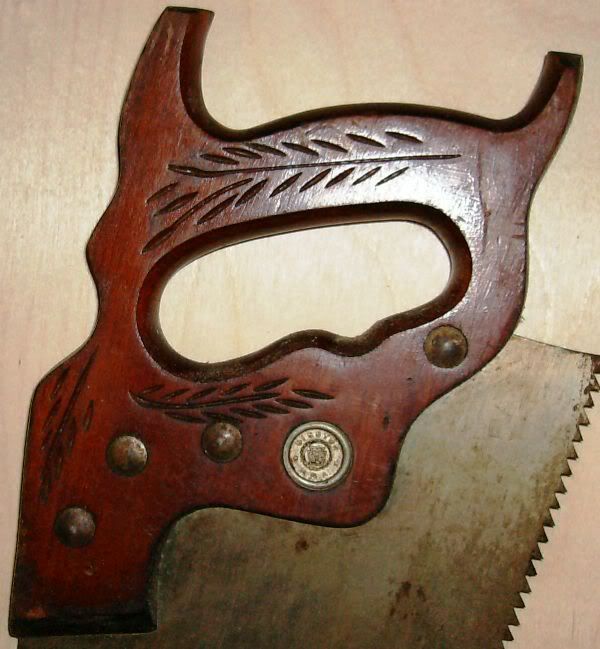As a novice with hand tools, I read the threads of making full pieces of furniture just using those tools, and dream of doing it myself. Okay, so one of the talents needed is using a handsaw to "rough out" the boards, as well as to resaw for those fine looking bookmatched panels.
Yesterday I was working on my walnut table, and with the 100% humidity, the wood in the pieces was 'moving" every time I did something to them, so I decided it was a good time to make some good clamping cauls for this glue up, as well as as for future work, so I wouldn't keep "cobbling something together". Looking around, all I could find in hardwood of enough size was an old red oak billet I had hacked out of a log with a chain saw. Too heavy and rough to push through the bandsaw, so I decided it was a good time to practice some hand tool skills.
I have two 26" handsaws: One Stanley that I have filed for cross-cut (that has given Jeff cause for mirth on occasion), and one Disston (found 20 years ago laying in the road covered with rust, but not an antique as it has a plastic handle) filed for rip cut. Pulled out the Disston, drew a straight line down the billet and went to sawing:

and sawing:

and ended up with this over an hour later (sawn face is on top):

But due to my lack of skill it was not flat so ended up back with the hand planes:

Lessons learned:
1. I theenk I need a bigger saw! I really can't see me sawing out 6 cauls out of this with what I have. 7 TPI is slow going and a stiffer blade would have helped. Now that I have flat face, the bandsaw will be getting a workout.
2. I need to do this more often as I got much better after 1/3 of the way through. Finally remembered to let the saw do the work and just push it with the web of my thumb/forefinger instead of forcing it
3. If I attempt this again, it will be in the winter when the shop is a 55 degrees, rather than 85 degrees and 100% humidity. I figure I will start in coveralls and end up in T-shirt and shorts!!
4. I also need to use my planes more often. Yesterday, after sawing, I attacked it all hot and sweaty and wanting to "get 'er dun!" Ended up with a twist and bow. Went out today and looked at what I had and made fairly quick work of getting it flat.
SO, while the dream is still there, constantly fed by my "heroes" on this site like Mike Davis, etc, it will be a while before I tackle a "log to loveseat" project just using hand tools.
Hope this doesn't get me kicked out of the neander wannabee club.:sad11::sad11:but I welcome any advice toward ways to do it better.
Go
Yesterday I was working on my walnut table, and with the 100% humidity, the wood in the pieces was 'moving" every time I did something to them, so I decided it was a good time to make some good clamping cauls for this glue up, as well as as for future work, so I wouldn't keep "cobbling something together". Looking around, all I could find in hardwood of enough size was an old red oak billet I had hacked out of a log with a chain saw. Too heavy and rough to push through the bandsaw, so I decided it was a good time to practice some hand tool skills.
I have two 26" handsaws: One Stanley that I have filed for cross-cut (that has given Jeff cause for mirth on occasion), and one Disston (found 20 years ago laying in the road covered with rust, but not an antique as it has a plastic handle) filed for rip cut. Pulled out the Disston, drew a straight line down the billet and went to sawing:

and sawing:

and ended up with this over an hour later (sawn face is on top):

But due to my lack of skill it was not flat so ended up back with the hand planes:

Lessons learned:
1. I theenk I need a bigger saw! I really can't see me sawing out 6 cauls out of this with what I have. 7 TPI is slow going and a stiffer blade would have helped. Now that I have flat face, the bandsaw will be getting a workout.
2. I need to do this more often as I got much better after 1/3 of the way through. Finally remembered to let the saw do the work and just push it with the web of my thumb/forefinger instead of forcing it
3. If I attempt this again, it will be in the winter when the shop is a 55 degrees, rather than 85 degrees and 100% humidity. I figure I will start in coveralls and end up in T-shirt and shorts!!
4. I also need to use my planes more often. Yesterday, after sawing, I attacked it all hot and sweaty and wanting to "get 'er dun!" Ended up with a twist and bow. Went out today and looked at what I had and made fairly quick work of getting it flat.
SO, while the dream is still there, constantly fed by my "heroes" on this site like Mike Davis, etc, it will be a while before I tackle a "log to loveseat" project just using hand tools.
Hope this doesn't get me kicked out of the neander wannabee club.:sad11::sad11:but I welcome any advice toward ways to do it better.
Go


